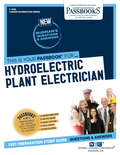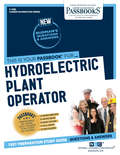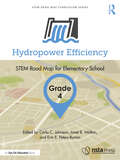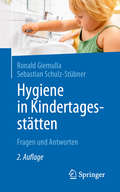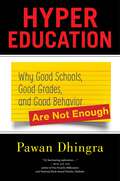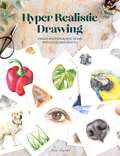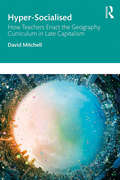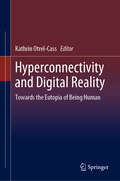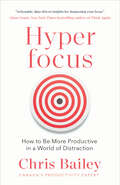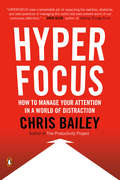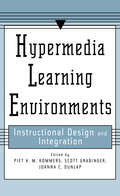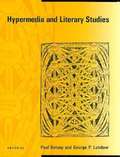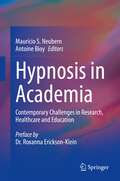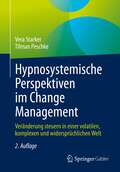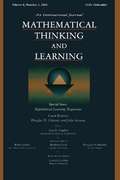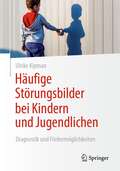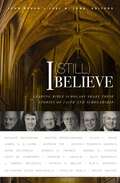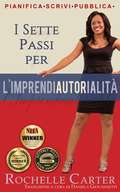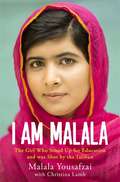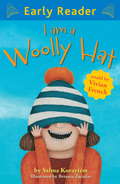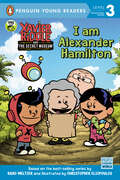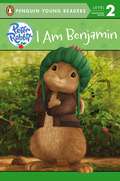- Table View
- List View
Hydroelectric Plant Electrician: Passbooks Study Guide (Career Examination Series)
by National Learning CorporationThe Hydroelectric Plant Electrician Passbook® prepares you for your test by allowing you to take practice exams in the subjects you need to study. It provides hundreds of questions and answers in the areas that will likely be covered on your upcoming exam, including but not limited to: maintenance and repair of mechanical equipment; basic arithmetic; mechanical principles; safety procedures; and more.
Hydroelectric Plant Operator: Passbooks Study Guide (Career Examination Series)
by National Learning CorporationThe Hydroelectric Plant Operator Passbook® prepares you for your test by allowing you to take practice exams in the subjects you need to study. It provides hundreds of questions and answers in the areas that will likely be covered on your upcoming exam, including but not limited to: maintenance and repair of mechanical equipment; basic arithmetic; mechanical and electrical principles; safety procedures; effective work within a staff; and more.
Hydropower Efficiency, Grade 4: STEM Road Map for Elementary School (STEM Road Map Curriculum Series)
by Carla C. Johnson Janet B. Walton Peters-Burton, Erin E.What if you could challenge your fourth graders to create a minimally invasive, highly efficient dam? With this volume in the STEM Road Map Curriculum Series, you can! Hydropower Efficiency outlines a journey that will steer your students toward authentic problem solving while grounding them in integrated STEM disciplines. Like the other volumes in the series, this book is designed to meet the growing need to infuse real-world learning into K–12 classrooms.This interdisciplinary, four-lesson module uses project- and problem-based learning to help students create a highly efficient dam that has a minimal impact on the environment. Students will explore the use of natural resources to provide energy needs, specifically hydropower, while exploring the workings of watermills, wind turbines, and generators to help build an understanding of the effects of dams. In creating their dam, they will learn about the various types of alternative hydropower sources, including wave and tidal power, and track the progress of electrification in the U.S. on a timeline; alongside researching the positive and negative consequences of hydropower.To support this goal, students will do the following: Use the engineering design process (EDP) to create a design for a dam, wind turbine, and water wheel Compare and contrast renewable power sources Evaluate power sources for efficiency Identify positive and negative consequences of human modifications of the environment Identify and describe how several sources of renewable energy are used across the U.S. Use mapping skills to determine where natural resources are being accessed for energy usage Effectively utilize shapes, materials, and measurements to create a model of a hydropower system The STEM Road Map Curriculum Series is anchored in the Next Generation Science Standards, the Common Core State Standards, and the Framework for 21st Century Learning. In-depth and flexible, Hydropower Efficiency can be used as a whole unit or in part to meet the needs of districts, schools, and teachers who are charting a course toward an integrated STEM approach.
Hygiene in Kindertagesstätten: Fragen und Antworten
by Sebastian Schulz-Stübner Ronald GiemullaDas Werk beschreibt verständlich und auf dem neuesten wissenschaftlichen Stand das aktuelle Wissen zur Vermeidung von Infektionskrankheiten in Kindertagesstätten. Es wendet sich v.a. an pädagogische Fachkräfte, wie Erzieherinnen und Erzieher, Auszubildende, Fachberater, Leitungen von Tageseinrichtungen für Kinder, aber auch an interessierte Eltern.Von den klassischen hygienischen Maßnahmen wie Händehygiene, Reinigung und Desinfektion, bis zu den Symptomen der wichtigsten Kinderkrankheiten, notwendige Maßnahmen in der Einrichtung, Therapie und Impfprävention werden übersichtlich dargestellt. Ausgewählte – für die Praxis relevante – Checklisten sowie die wichtigsten Regeln für die Erste Hilfe unter hygienischen Gesichtspunkten runden das Werk ab. Durch den Frage-Antwort-Aufbau der einzelnen Kapitel ist das Werk sowohl für die erste Auseinandersetzung mit hygienischen Themen als auch als Repetitorium für erfahrene Fachkräfte geeignet. Die 2. Auflage erscheint komplett aktualisiert und erweitert.
Hyper Education: Why Good Schools, Good Grades, and Good Behavior Are Not Enough
by Pawan DhingraAn up-close look at the education arms race of after-school learning, academic competitions, and the perceived failure of even our best schools to educate childrenBeyond soccer leagues, music camps, and drama lessons, today’s youth are in an education arms race that begins in elementary school. In Hyper Education, Pawan Dhingra uncovers the growing world of high-achievement education and the after-school learning centers, spelling bees, and math competitions that it has spawned. It is a world where immigrant families vie with other Americans to be at the head of the class, putting in hours of studying and testing in order to gain a foothold in the supposed meritocracy of American public education. A world where enrichment centers, like Kumon, have seen 194 percent growth since 2002 and target children as young as three. Even families and teachers who avoid after-school academics are getting swept up. Drawing on over 100 in-depth interviews with teachers, tutors, principals, children, and parents, Dhingra delves into the why people participate in this phenomenon and examines how schools, families, and communities play their part. Moving past "Tiger Mom" stereotypes, he addresses why Asian American and white families practice what he calls "hyper education" and whether or not it makes sense. By taking a behind-the-scenes look at the Scripps National Spelling Bee, other national competitions, and learning centers, Dhingra shows why good schools, good grades, and good behavior are seen as not enough for high-achieving students and their parents and why the education arms race is likely to continue to expand.
Hyper Realistic Drawing: Create Photorealistic 3D Art with Coloured Pencils
by Amie HowardLearn how to create realistic 3D art with this collection of step-by-step techniques and tutorials for creating hyperrealistic art using coloured pencils. The trend for hyper realistic artworks featuring high shine subjects is inspiring a new generation of artists. Take your art to the next level with this collection of step-by-step techniques and tutorials for creating hyper realistic artwork. Artist and author, Amie Howard, is an expert in how to get the most from coloured pencils and she takes you through all the key techniques for rendering realistic representations of everything from pets to water. The first part of the book explores basic drawing techniques including blending, shading, glazing and scumbling - a technique used to create a slick surface texture. There are simple practise exercises for each of the techniques sections so that you can experiment and get comfortable with the different methods before trying them out on a final artwork. This section includes advice about how to get the perfect blend of colours and textures as well as tips about adding in the fine details that make all the difference. The step-by-step tutorials feature a wide range of subjects including animals, portraits, food and drink so you will learn how to recreate a large number of different surfaces and textures. The chapters are broken up into sections: Surfaces; Animals; Birds, People and Other Textures which looks at a range of different natural and synthetic textures including tree bark, grass, a soft drink can and a shiny sweet wrapper. All of the tutorials have multiple step-by-step images so you can see how the forms and textures are built up over a series of stages. Amie shares her tips and tricks for creating incredibly realistic representations of textures including feathers and fur and there are up close studies for a cat's eye, a dog's nose and a single feather so you can the details involved in these projects. Other up close studies include lips and a nose and a bird's beak and eye. The instructions will allow you tackle challenging subjects such as ripples on water and ice in glass by breaking down the drawing process into clear step-by-step instructions and photographs, allowing you to follow the artist at each step.
Hyper-Learning: How to Adapt to the Speed of Change
by Edward D. Hess"Ed Hess's Hyper-Learning is uniquely practical and is the essential starting point for charting new ways of thinking, living, working, leading, and being fulfilled in our new world." —Gary Roughead, Admiral, US Navy (retired) former Chief of Naval Operations The Digital Age will raise the question of how we humans will stay relevant in the workplace. To stay relevant, we have to be able to excel cognitively, behaviorally, and emotionally in ways that technology can't.Professor Ed Hess believes that requires us to become Hyper-Learners: continuously learning, unlearning, and relearning at the speed of change. To do that, we have to overcome our reflexive ways of being: seeking confirmation of what we believe, emotionally defending our beliefs and our ego, and seeking cohesiveness of our mental models. Hyper-Learning requires a new way of being and a radical new way of working. In Part 1 of this how-to book, Hess takes a practical workbook approach and helps readers create their Hyper-Learning Mindset, choose and embrace their needed Hyper-Learning Behaviors, and adopt their daily Hyper-Learning Practices. In Part 2, Hess focuses on how to humanize the workplace to optimize Hyper-Learning. Featuring case studies of three business leaders and two public companies, this book shows how to harness the power of human emotions, choices, and behaviors to enable the highest levels of human cognitive, emotional, and behavioral performance—individually and organizationally.
Hyper-Socialised: How Teachers Enact the Geography Curriculum in Late Capitalism
by David MitchellHyper-socialised explores the challenges of late capitalist times for education systems, schools and teachers. It looks at how trends of accountability, ‘teaching to the test’, using pupil voice and reliance on network technologies are all connected to powerful social and economic forces, shaping the curriculum as it is taught in classrooms. Such forces threaten to overwhelm teachers but, in the right hands, they can also be harnessed to create, influence and teach a truly powerful curriculum for their students. Presenting a historical view of curriculum change, the book examines how society, curriculum and teachers are linked. Using geography as an illustrative subject, the chapters investigate what influences teachers, to what extent they are in control of the curriculum, and what else is shaping it. Divided into two parts, it offers An in-depth exploration of the relationship between society, teachers and the curriculum, including that what and how to teach remain wide open to debate Evidence-based research into the significance and implications of ‘hyper-socialised’ curriculum enactment for teachers and teacher education Four case study ‘portraits’ of geography departments and personal curriculum stories of each Head of Department Insights into the nature of teaching as a profession and how a crisis of teacher recruitment and retention may be addressed. Written in clear and accessible terms, this book is an essential resource for teacher educators, subject teachers, headteachers and educational researchers who want to understand how and why schools and teaching are changing – and what this means for them.
Hyperconnectivity and Digital Reality: Towards the Eutopia of Being Human
by Kathrin Otrel-CassThis book addresses the topic of hyperconnectivity by building on, expanding, and critically examining issues that have to do with information communication technology (ICT) and networked societies. The book explores questions relating to attention and consciousness, techno-capitalism and communicative action taking. Adopting different philosophical angles to assess the challenges we face due to our entanglement with hyperconnected technologies, the book studies performance and performativity in a digitised world by considering the unfolding of our onlife and by looking at what this means to educated future scientists and engineers in a hyperconnected world. The book further discusses digital activities as the new constructs of ourselves and poses questions about how much literacy is needed for us not to be enslaved by those constructs. The book also explores the challenges of hyperconnectivity and the health sector to showcase the vulnerabilities we are increasingly exposed to. It makes clear that - since the boundaries between on- and offline are becoming increasingly blurred - we will require new, flexible frameworks that reconsider what it means to be human in a hyperconnected world.
Hyperfocus: How to Be More Productive in a World of Distraction
by Chris BaileyCanada's productivity expert returns with a totally fresh angle on how to do more with less.Throughout his experiments and research, Chris Bailey came across many little-known insights into how we focus (a key element of productivity), including the surprising idea that focus isn't so much a state of heightened awareness (as we'd assume), but a balance between two frames of mind. The most recent neuroscientific research on attention reveals that our brain has two powerful modes that can be unlocked when we use our attention well: a focused mode (hyperfocus), which is the foundation for being highly productive, and a creative mode (scatterfocus), which enables us to connect ideas in novel ways. Hyperfocus helps readers unlock both, so they can concentrate more deeply, think more clearly, and work and live more deliberately. Diving deep into the science and theories about how and why we bring our attention to bear on life's big goals and everyday tasks, Chris Bailey takes his unique approach to productivity to the next level in Hyperfocus, while retaining the approachable voice and perspective that made him a fast favourite.
Hyperfocus: How to Be More Productive in a World of Distraction
by Chris BaileyA practical guide to managing your attention--the most powerful resource you have to get stuff done, become more creative, and live a meaningful lifeOur attention has never been as overwhelmed as it is today. Many of us recognize that our brains struggle to multitask. Despite this, we feel compelled to do so anyway while we fill each moment of our lives to the brim with mindless distraction. Hyperfocus provides profound insights into how you can best take charge of your attention to achieve a greater sense of purpose and productivity throughout the day.The most recent neuroscientific research reveals that our brain has two powerful modes that can be unlocked when we use our attention effectively: a focused mode (hyperfocus), which is the foundation for being highly productive, and a creative mode (scatterfocus), which enables us to connect ideas in novel ways. Hyperfocus helps you access each of the two mental modes so you can concentrate more deeply, think more clearly, and work and live more deliberately every day. Chris Bailey examines such topics such as: * identifying and dealing with the four key types of distraction and interruption; * establishing a clear physical and mental environment in which to work; * controlling motivation and working fewer hours to become more productive; * taking time-outs with intention; * multitasking strategically; and * learning when to pay attention and when to let your mind wander wherever it wants to.By transforming how you think about your attention, Hyperfocus reveals that the more effectively you learn to take charge of it, the better you'll be able to manage every aspect of your life.
Hypermedia Learning Environments: Instructional Design and Integration
by Piet A. M. Kommers Scott Grabinger Joanna C. DunlapHypermedia and multimedia have penetrated the world of computer games, Internet, and CD-ROM based reference manuals. However, the fields of education, schooling, and training ask more specific benefits from them. This book provides practical approaches to transform these media into learning tools. Crucial helping steps include the migration from expository to exploratory learning strategies, the integration of collaborative learning practices in plenary and individualistic teaching styles, and the evolution from test-driven to experience-oriented training. This volume has three goals: * to discuss the concepts of hypermedia, multimedia, and hypertext and review pertinent research lines; * to provide guidelines and suggestions for developing multimedia applications; and * to place technology within a broader context of education and training through a discussion of rich environments for active learning (REALs). The book takes a developmental focus to helpf readers set up and manage the process of developing a multimedia application. It is not a technical or a how-to manual on working with video, sound, digitized graphics, or computer code. The text takes a unique approach to the idea of media-- viewing media as delivery systems: if video is called for, use it; if sound will help in an application, use it. The fundamental guidelines presented here are usually not media specific. Media works only within the strategies with which they are used. Aimed at practitioners--people who teach about or develop multimedia and hypermedia applications--this volume carefully examines the main components and issues in developing applications. It provides suggestions and heuristics for sound, fundamental design processes.
Hypermedia and Literary Studies
by Paul Delany George P. LandowThe essays in Hypermedia and Literary Studies discuss the theoretical and practical opportunities and challenges posed by the convergence of hypermedia systems and traditional written texts.
Hypertext and Cognition
by Jean-François Rouet Rand J. Spiro Andrew Dillon Jarmo J. LevonenThe recent evolution of western societies has been characterized by an increasing emphasis on information and communication. As the amount of available information increases, however, the user -- worker, student, citizen -- faces a new problem: selecting and accessing relevant information. More than ever it is crucial to find efficient ways for users to interact with information systems in a way that prevents them from being overwhelmed or simply missing their targets. As a result, hypertext systems have been developed as a means of facilitating the interactions between readers and text. In hypertext, information is organized as a network in which nodes are text chunks (e.g., lists of items, paragraphs, pages) and links are relationships between the nodes (e.g., semantic associations, expansions, definitions, examples -- virtually any kind of relation that can be imagined between two text passages). Unfortunately, the many ways in which these hypertext interfaces can be designed has caused a complexity that extends far beyond the processing abilities of regular users. Therefore, it has become widely recognized that a more rational approach based on a thorough analysis of information users' needs, capacities, capabilities, and skills is needed. This volume seeks to meet that need. From a user-centered perspective -- between systems and users -- this volume presents theoretical and empirical research on the cognitive processes involved in using hypertext. In so doing, it illustrates three main approaches to the design of hypertext systems: *cognitive, which examines how users process multilayered hypertext structures; *ergonomical, which explores how users interact with the design characteristics of hardware and software; and *educational, which studies the learning objectives, frequency and duration of hypertext sessions, type of reading activity, and the user's learning characteristics. This volume also tries to provide answers for the questions that have plagued hypertext research: *What is hypertext good for? *Who is hypertext good for? *If it is useful for learning and instruction, then what type? *What particular cognitive skills are needed to interact successfully with a hypertext system? Anyone interested in the fields of computer science, linguistics, psychology, education, and graphic design will find this volume intriguing, informative, and a definitive starting point for future research in the field of hypertext.
Hypnosis in Academia: Contemporary Challenges in Research, Healthcare and Education
by Maurício S. Neubern Antoine BioyThis book analyzes the growing presence of hypnosis in academic settings around the world and its implications for research, healthcare and education. The increasing volume of scientific research on hypnosis and its clinical applications to treat health conditions such as pain, anxiety, trauma and depression has renewed the interest for this kind of practice in different disciplines, such as medicine, psychology, dentistry and nursing. As a result of this growing interest, there is an increasing number of spaces occupied by hypnosis in universities of different countries compared to what occurred in recent decades. Nevertheless, what this means, at various levels, is still far from being deciphered, due to the absence of more detailed research and surveys involving a larger number of institutions, students, faculty and research groups. This volume intends to shed a new light into the discussions about the growing presence of hypnosis in academia by bringing together contributions of practitioners and researchers working with hypnosis in academic settings in ten countries from different parts of the world: Belgium, Brazil, Canada, Cuba, France, Hungary, Israel, Portugal, Russia and Switzerland. The discussions presented in these contributions revolve around four axes of analysis: the historical trajectory of hypnosis within academic institutions; the epistemological nature of hypnosis and its relationships with other fields of knowledge; the importance of scientific research for the current development of hypnosis and its clinical applications; and how teaching and training in hypnosis is organized in universities today, with its ethical and legal implications in different cultural contexts. Hypnosis in Academia: Contemporary Challenges in Research, Healthcare and Education will be a great resource for both researchers and practitioners working with hypnosis, and a valuable source of information for human and social scientists in general interested in understanding how a once discredited practice regained respect from the academic community and is now a growing topic of interest for scholars and clinicians all around the world.
Hypnosystemische Perspektiven im Change Management: Veränderung steuern in einer volatilen, komplexen und widersprüchlichen Welt
by Vera Starker Tilman PeschkeDieses in zweiter Auflage komplett überarbeitete und erweiterte Buch stellt hypnosystemische und neurobiologische Ansätze zur Gestaltung von Veränderungsprozessen vor, mit dem Ziel, die Entwicklungsvarianz von Unternehmen in einer volatilen und komplexen Welt zu steuern und zu erhöhen. Unter Darstellung aktueller methodischer und empirischer Perspektiven zum Thema Change Management gehen die Autorin und der Autor vor allem der Frage nach, warum sich – trotz jahrzehntelanger Professionalisierung von Change-Management-Methoden – keine Steigerung der Erfolgsraten von Veränderungsprozessen verzeichnen lässt.Sie stellen neben konkreten Prozessgestaltungsansätzen unter anderem Vorschläge zu einer zieldienlichen Führung, zu einer wirksamen Team- und Kooperationsentwicklung sowie zur Messung von Veränderungsprozessen vor und eröffnen damit Management und Führungskräften neue Wege, die Erfolgswahrscheinlichkeit von künftigen Veränderungsprozessen, insbesondere im Hinblick auf die Anforderungen der digitalen Transformation und einer sich immer schneller wandelnden Welt, positiv zu beeinflussen. Der Inhalt Change Management aus hypnosystemischer SichtAktuelle Perspektiven und Erfolgswahrscheinlichkeiten im Change Management in einer volatilen und komplexen Welt Hypnosystemischer Beratungsansatz nach Gunther SchmidtAufbau eines Beratungs- und Steuerungssystems für Veränderungsprozesse
Hypothetical Learning Trajectories: A Special Issue of Mathematical Thinking and Learning
by Douglas H. Clements Julie SaramaThe purpose of this special issue is to present several research perspectives on learning trajectories with the intention of encouraging the broader community to reflect on, better define, adopt, adapt, or challenge the concept. The issue begins by briefly introducing learning trajectories. The remaining articles provide elaboration, examples, and discussion of the construct. They purposefully are intended to be illustrative, exploratory, and provocative with regard to learning trajectories construct; they are not a set of verification studies.
Häufige Störungsbilder bei Kindern und Jugendlichen: Diagnostik und Fördermöglichkeiten
by Ulrike KipmanDieses Buch erklärt anhand von Praxisbeispielen häufige und auch oft unerkannte Verhaltensauffälligkeiten, Lernstörungen und emotionale Störungen bei Kindern und Jugendlichen. Es beinhaltet ausgewählte F8X und F9X Diagnosen im Überblick, Informationen zur Diagnostik und vor allem Fördermöglichkeiten für den häuslichen und schulischen Kontext.
I (Still) Believe: Leading Bible Scholars Share Their Stories of Faith and Scholarship
by Joel N. Lohr John ByronI (Still) Believe explores the all-important question of whether serious academic study of the Bible is threatening to one’s faith. Far from it—faith enhances study of the Bible and, reciprocally, such study enriches a person’s faith. With this in mind, this book asks prominent Bible teachers and scholars to tell their story reflecting on their own experiences at the intersection of faith and serious academic study of the Bible. While the essays of this book will provide some apology for academic study of the Bible as an important discipline, the essays engage with this question in ways that are uncontrived. They present real stories, with all the complexities and struggles they may hold. To this end, the contributors do two things: (a) reflect on their lives as someone who teaches and researches the Bible, providing something of a story outlining their journey of life and faith, and their self-understanding as a biblical theologian; and (b) provide focused reflections on how faith has made a difference, how it has changed, and what challenges have arisen, remained, and are unresolved, all with a view toward the future and engaging the book’s main question. engaging the book’s main question.
I 7 Passi per l'Imprendiautorialità
by Daniela Giovannetti Rochelle CarterSto per condividere un piccolo segreto con te, gratis: L'unico modo per far notare il tuo libro come vorresti tu è investire su te stesso. Forse suona strano. Investire su me stesso, non sul mio libro? Be', il segreto è che investendo su te stesso come persona, stai investendo anche sul tuo libro. Non puoi solo vendere un'idea o un libro a un editore o a un pubblico: devi vendere anche te stesso. Ti starai chiedendo:come fare? Diventa quello che viene definito "imprendiautore": un autore che non è solo un creativo ma anche un uomo d'affari che lavora per se stesso/a. "Imprendiautore" non è la nuova parola alla moda. Specifica lo stato mentale di cui hai bisogno prima, durante e anche dopo aver pubblicato il tuo libro. Non importa se decidi di pubblicarlo indipendentemente (go "indie") o tradizionalmente, se vuoi gestire il marketing per conto tuo o incaricare qualcun altro. La mentalità è sempre la stessa: tu stai determinando e gestendo la tua carriera da scrittore, a modo tuo.
I AM MALALA - The Girl Who Stood Up for Education and was Shot by the Taliban
by Malala Yousafzai Christina LambI AM MALALA is the remarkable tale of a family uprooted by global terrorism, of the fight for girls' education, of a father who, himself a school owner, championed and encouraged his daughter to write and attend school, and of brave parents who have a fierce love for their daughter in a society that prizes sons.
I Am A Woolly Hat (Early Reader)
by Vivian French Salma KoraytemEarly Readers are stepping stones from picture books to reading books. A blue Early Reader is perfect for sharing and reading together. A red Early Reader is the next step on your reading journey.Basma has been wondering a lot about love. What is it like? Does it have a shape or a colour or a taste? Is it like a coat or a jumper or a shawl? Or is it like a warm woolly hat? This charming new Early Reader story from the United Arab Emirates will be enjoyed by everyone, parents and children alike - and in particular fans of GUESS HOW MUCH I LOVE YOU.
I Am Alexander Hamilton (Xavier Riddle and the Secret Museum)
by Nancy ParentA leveled Reader based on an episode from the PBS KIDS animated television series Xavier Riddle and the Secret Museum starring Alexander Hamilton.Based on the children's book series Ordinary People Change the World by New York Times bestselling author Brad Meltzer and illustrator Christopher Eliopoulos, the series will introduce kids to inspiring historical figures and the character virtues that helped them succeed. It's time for Yadina to start first grade, but she's really nervous. Alexander Hamilton helps her realize that new adventures can be exciting. This episode-based Penguin Young Reader is perfect for emerging readers!
I Am Benjamin (Peter Rabbit Animation)
by Penguin Young ReadersMeet Benjamin Bouncer!Best friend to Peter Rabbit and Lily Bobtail, Benjamin is the comic relief in the show. He's always hungry, the most timid of the trio, and yet the most loyal friend there is. Benjamin, Peter, and Lily are ready for another adventure. Let's hop to it!
I Am Brave!: An Acorn Book (Princess Truly)
by Kelly GreenawaltPrincess Truly is not afraid of anything, in these rhyming stories perfect for early readers!Pick a book. Grow a Reader!This series is part of Scholastic's early reader line, Acorn, aimed at children who are learning to read. With easy-to-read text, a short-story format, plenty of humor, and full-color artwork on every page, these books will boost reading confidence and fluency. Acorn books plant a love of reading and help readers grow!Princess Truly knows how to be brave! She is going on a camping trip with her little brother Ty and her trusty dog, Sir Noodles. Nothing can scare Princess Truly: She is not afraid of the dark cave, the bugs and spiders, or even when something goes "bump" in the middle of the night. But when Princess Truly gets the hiccups, will Ty be able to find a way to scare his fearless big sister? These funny and empowering short stories promote believing in yourself, building confidence, and having a positive self-image, and foster imagination and curiosity. With full-color artwork and easy-to-read rhyming text throughout, this series is perfect for new readers!
